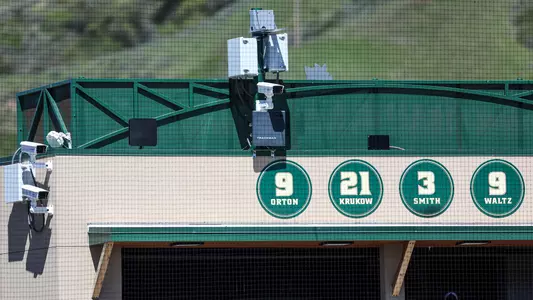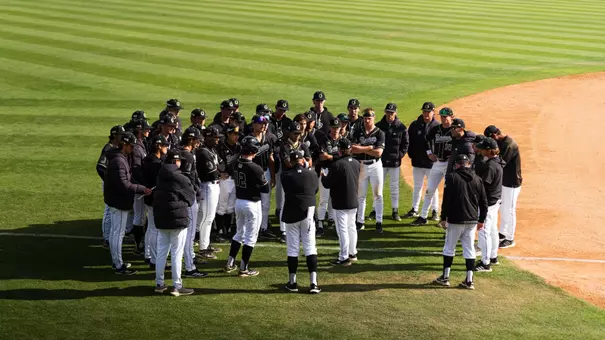
Cal Poly Baseball Adopts Groundbreaking Analytics System
3/21/2025 2:15:00 PM | Baseball
SAN LUIS OBISPO, Calif. — Cal Poly, a college baseball program renowned for its ability to develop and produce professional-level talent, is making history both on and off the field this season.
Prior to their series against #6 Oregon State this week, the Mustangs became the first mid-major and seventh NCAA baseball program overall to adopt KinaTrax, a markerless motion capture technology that combines biomechanical, analytical, and kinesiological data to help improve development, injury recovery and prevention, and general knowledge of how an athlete’s movements affect their body.
Though the technology has been widely adopted throughout Major League Baseball, Cal Poly joins Arizona, Arkansas, Auburn, Miami, Stanford, and Wake Forest as the only college programs to have in-stadium versions of KinaTrax.
The system consists of 16 cameras, eight focused on the pitcher and eight on the batter. Those motion capture devices have already been installed around Baggett Stadium and will finally start collecting in-game data during this weekend’s home series.
The numbers don't lie, they tell the story of the game. We just need to know how to interpret them.Bill James, Baseball Historian and Statistician

Cal Poly Baseball continues to be one of the best programs in the country for philanthropic investment from baseball alumni, alumni at large, and the San Luis Obispo Community. The Kinatrax technology required $500,000 in gifts to fund the technology and installation.
Baseball alumni David Mossman (Cal Poly ‘91) invested in the upgrade and commented on why he supported: “1. Enhancing Player Performance – Improved motion-tracking capabilities can provide more precise biomechanical insights, helping players refine their mechanics and reduce injury risk. 2. Injury Prevention & Recovery – More advanced tracking can help identify potential injury risks before they become serious issues, assisting in player longevity and rehabilitation. 3. Competitive Advantage – Teams using enhanced Kinatrax systems may gain an edge in scouting, player development, and in-game strategy.”
Jason Maas, a Cal Poly ‘85 baseball alumni, also lauded the system’s benefits: “As a former CP and professional athlete, I benefited from cutting edge and advanced training tools and methods throughout my career. Fast forward to today’s digital era, there is no greater training aid than Kinatrax. The combination of precise motion capture, artificial intelligence analytics and hands-on biomechanical application through the CP kinesiology department creates a dynamic, next-level program advancement in all areas related to performance, injury prevention, recruiting, and staffing.”
Baseball alumni David Mossman (Cal Poly ‘91) invested in the upgrade and commented on why he supported: “1. Enhancing Player Performance – Improved motion-tracking capabilities can provide more precise biomechanical insights, helping players refine their mechanics and reduce injury risk. 2. Injury Prevention & Recovery – More advanced tracking can help identify potential injury risks before they become serious issues, assisting in player longevity and rehabilitation. 3. Competitive Advantage – Teams using enhanced Kinatrax systems may gain an edge in scouting, player development, and in-game strategy.”
Jason Maas, a Cal Poly ‘85 baseball alumni, also lauded the system’s benefits: “As a former CP and professional athlete, I benefited from cutting edge and advanced training tools and methods throughout my career. Fast forward to today’s digital era, there is no greater training aid than Kinatrax. The combination of precise motion capture, artificial intelligence analytics and hands-on biomechanical application through the CP kinesiology department creates a dynamic, next-level program advancement in all areas related to performance, injury prevention, recruiting, and staffing.”
We’re on the cutting edge of data that is going towards the development and health of the players. We’re very fortunate to have this system. It’ll help us in the recruiting sphere, and we’re also able to promise players that we can do absolutely everything possible to make them better. One of the main advantages is for players' health, see when they’re fatigued, when something is off about their movements, and when a player is about to do something harmful to their bodies.Pitching Coach Seth Moir
Cal Poly interviewed Robert Hulbert, former Coordinator of Integrative Sports Performance for the Milwaukee Brewers and current Director of Product Development for KinaTrax, to explain exactly how the system works, the wide range of uses it has, and how Cal Poly came to be the first mid-major to adopt the in-stadium technology.
One of the system’s major attractions is the MLB’s adoption of KinaTrax and how important the data is to aspiring professional baseball players and current talent evaluation teams at the game’s highest level, with Hulbert saying, “First and foremost, this can be widely used as a recruiting tool. MLB teams have the option to receive player data from any KinaTrax system, which is helpful for draft purposes and college players getting exposure to professional evaluators.”
Hulbert likened the technology to what current motion capture systems accomplish, but that KinaTrax is more advanced in that it does not require special suits, markers, and guides like most current technologies: “In simple terms, we are a motion capture company, but we specialize in in-game competitive environments, which makes us unique as we can immediately grab pitcher and batter biomechanical data.”
These 16 cameras and motion capture systems are already synchronized and KinaTrax encodes the data it grabs and sends it to a machine-learning algorithm that takes the data and applies skeletal animation. Further information, including image-generated examples of how the data looks can be found here.
We’re very lucky that our boosters wanted to give us something that will help in the overall development of our program. It’s a unique system and we’re looking forward to utilizing all the best parts of it, especially as time goes on and we become more familiar with it.Head Coach Larry Lee
“Once those skeletal movements are identified, we have biomechanical algorithms that analyze the physics of the body: joint angles, velocities, torques, power, etc. We then synchronize that with batting and ball characteristics - such as velocity, movement, spin rate, and other things - that the Trackman system provides, so we can start to allow teams to study and learn about the biomechanics that create good performance and healthy physical movement for the athletes,” Hulbert went on to say.
Raw video and footage that has been used for decades by scouts, evaluators, and coaches is very powerful but KinaTrax allows programs to quantify the data and validate everything they have been seeing, comparing and contrasting data, especially as players grow, recover from injuries, as well as comparing players from season-to-season.
Discussing its incredibly helpful uses beyond coaching, Hulbert said, “The holy grail of KinaTrax is using it to prevent injuries. I think where this especially helps at the college level, it allows teams to get a baseline of their players. A lot of times, these types of systems are used in lab situations for testing bodily movements, but this system is meant to be used specifically in a competitive environment where one can see every single bodily mechanic.”
Hulbert continued by saying, “Tracking the data over time, you can see if motion patterns are starting to change, or if mechanics are trending in the wrong direction. If you do have an injury, it helps in the rehab, and answers questions like, ‘Can we get them back to their baseline or what do we need to change to avoid an injury again?’”
Hulbert then closed by explaining how the program came to acquire such an advanced and important piece of technology: “Part of the process is having connections with our commercial teams. When we try to identify schools, we want programs in high-profile areas, and MLB teams have recommended interest in certain schools that provide high levels of talent to the professional game. Cal Poly came to be in that conversation.”
Using it as a recruiting draw is helpful, but professional teams and players alike are beginning to see the benefits of KinaTrax. Hulbert pointed out that, “There might be fringe college players who come in and can develop and grow dramatically. Ideally, the program will see KinaTrax paying major dividends as it turns middle-to-bottom roster players into professionals or takes already high-profile talents to a whole new level never thought possible.”
Getting in on the ground floor with this technology allows Cal Poly the chance to have a competitive advantage over not just the conference but the entire state of California and college baseball, both on and off the field.
Here are just a few examples of how the markerless motion capture technology tracks movements in the moment! ??#RideHigh pic.twitter.com/gnR4F5FFmX
— Cal Poly Baseball (@CalPolyBSB) March 21, 2025



















